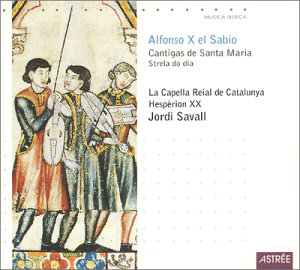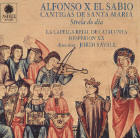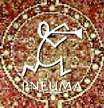Alfonso X el Sabio
Cantigas de Santa MariaArtistes / Performers
Ensemble Hespèrion XX, La Capella Reial de Catalunya / direction: Jordi Savall
Lieu d'enregistrement / Recording site:
Collégiale romane du Château de Cardona, Catalogne
Date d'enregistrement: février 1993
Recording date: February 1993Durée totale / Total time: 70'15
Édition originale/Original recording
Astrée - 8508
Gramophone-
(__/____)
(English)
- Texte intégral anglais
- Full text
Analyste: Mary Berry
Condensé (traduction libre):
"Un enregistrement tout empreint de charme et de simplicité. Les courtes mélodies modales sont irrésistibles... produisant ... un effet incantatoire..."
Voilà qui nous semble bien résumer des commentaires d'une neutralité très courtoise
Reviewer: Mary Berry
Abridged version-:
"It is a recording of immense charm and simplicity. The short modal melodies are compelling, even after the constant repetition of multiple stanzas. The effect of these on the ear is rather like an incantation and as two of these tunes occupy more than a third of the entire recording one might expect the result to be monotonous. Quite the contrary: some variety is introduced by the use of canon or discreet accompaniment, but the melodies themselves (Muito faz grand'erro and De toda chaga ben pode guarir) can bear this constant repetition."
Goldberg
# 1, (Automne/Fall 1997)
(English)Appréciation
Evaluation
Analyste: Sophie Roughol
Résumé ou abrégé:
Reviewer: Sophie Roughol
Original text :
This commentary is a continuation of an article entitled "Cantiguas" published in Goldberg (no. 1).
"Savall is always Savall, whatever the repertoire. His inclination towards the hedonistic, the luxuriant, and the dazzling array of colours and rythms, always maintain the force of irrepressible seduction. His Cantiguas are the exact opposite of those of Sequentia (Deutsche Harmonia Mundi 054722 77173 2 - 1991). You will find here no precise historical reference, no contrast in inspiration. They are all cast in the same mould, as though the codex followed only one form. Indeed, both the vocal style and the instrumental realizations carry the anachronistic stamp of a vaguely orientalizaing Hispanic renaissance or pre-baroque, devilishly attractive but cautious. What is the reality of the world which Savall evokes ? That of Sequentia, more demanding, seem also to be the truest".
Quelques extraits du texte du livret, signé Jesus Martín Galán:
A few excerpts from the liner notes by Jesus Martín Galán:
Le terme cantiga ... (sert à) désigner une composition poético-musicale, sacrée et profane en langue galaïco-portugaise... Les Cantigas de Santa Maria, comprenant plus de quatre cents oeuvres consacrées à la Vierge, furent sans doute rassemblées dans la deuxième moitié du XIIIe s., entre 1250 et 1280, sous le contrôle du roi de Castille de cette époque, Alphonse X "le Sage"... "Sa tâche fut surtout d'organiser, diriger et corriger .. (conséquemment) c'est donc à lui que semble revenir l'homogénéité stylistique de l'oeuvre"...
"La thématique générale des Cantigas est la narration des miracles survenus par l'intercession de la Vierge (appelés Cantigas de miragre). Cependant, au fil du recueil, toutes les dix pièces, il en apparaît une... qui possède une intention plus lyrique. Elles appartiennent à celles qu'on appelle les Cantigas de loor, qui louent la Vierge, qui la remercient de son rôle médiateur ou qui chantent ses vertus". (CSM 100, CSM 400 sur le disque)
Jesus Martín Galán conclue son article en s'interrogeant sur les motifs "... qui poussèrent le roi sage à rassembler systématiquement des chansons en l'honneur de la Vierge..." Il répond en nous rappelant que ce recueil a été constitué "à un moment où la poésie troubadouresque est complètement associée à l'idée de l'amour courtois (et que par conséquent) faire d'Alphonse X le Sage la figure d'un troubadour qui chante sa dame idéalisée, la Vierge Marie en personne, n'est pas du tout une idée erronée... Le concept divinisé de la femme dans la poésie médiévale¹ a pu donner lieu à l'apparition de cette littérature mariale... De ce point de vue, la collection suppose fondamentalement la sacralisation du fin'amor ou, pour citer Ismeal Fernández de la Cuesta, le transfert au divin de l'attitude troubadouresque"
Traduction du texte original espagnol: Janine Lafont
Adaptation: "Classic @ la Carte" :
"The word cantiga... (is used) to describe a poetic-musical composition, whether religious or secular, in the Galician - Portuguese language...
"..the Cantigas de Santa Maria, with more than four hundred works dedicated to the Virgin, must have been composed in the second half of the XIII century, around 1250-80, under the direction of Alfonso X, "the Wise", who was then King of Castille"... "His was the important work of organization, direction and correction... (consequently) ... the stylistic unity of the work is also to his merit"...
"The general subject of the Cantigas is the narration of the miracles brought about bu the intercession of the Virgin (called Cantigas de miragre). Throughout the collection, however, for every ten pieces there appears one... which has a more lyrical purpose. These are known as the Cantigas de loor, in which the Virgin Mary is praised, her role as a mediator is appreciated, or her virtues are sung. (CSM 100, CSM 400 on the CD)
Jesus Martín Galán concludes his article by questionning the "... motivations of the wise king to undertake the task of systematically assembling songs in honour of the Virgin..." He answers by reminding us that the collection was assembled "at a time when poetry of the troubadours was completely associated with the idea of "courtly love", (and consequently)it must not have been thought at all strange to see Alfonso X, the Wise as a troubadour singing to his ideal lady, who is none other than the Virgin Mary... The exalted concept of woman in Provençal poetry could have brought about the appearance of this type of Marian literature... Seen in this light, the collection essentially implies giving a sacred character to the fin'amor, or, to quote (Ismeal) Fernández de la Cuesta, the transference of the troubadour attitude to the divine"
Translation from the original Spanish text: Angela Buxton
Adaptation: "Classic @ la Carte"
"Cantigas" by Sophie Roughol in Goldbgerg, # 1, pp.43-49. (In English)
Excellent article with a comparative discography.
Autres références disponibles via la base de données de Todd McComb:
(Site: http://www.medieval.org)Other available references via
Todd McComb's date base:
(Site: http://www.medieval.org)
La musique / The music
CSM 176: Introductio CSM 037: Miragres fremosos faz por nos CSM 100: Santa Maria, strela do dia CSM 77-119: Instrumental CSM 400: Pero cantigas de loor CSM 126:De toda chaga ben pode guarir
CSM 123: Instrumental CSM 181: Pero que seja a gente CSM 209: Muito faz grand'erro CSM 176: Conclusion
CSM 018: Por nos de dulta tirar
CSM 142: Instrumental CSM 163: Pode por Santa Maria Des liens à visiter / Links of interest
Autres sites d'intérêt
Useful links
Camino a Santiago
Le chemin de Saint-Jacques
(Version française)The Eduardo Paniaga project for PNEUMA
Musiques et Poésies
Médiévales
(Les cantigas de Santa Maria)SCA Medieval and Renaissance Music
-- The Cantigas de Santa Maria
Date de création de cette fiche: 4 avril 2006
Dernière mise à jour de cette fiche:
23-déc.-2021
This page was first published on:
April 4, 2006
This page was updated on:
12/23/21




